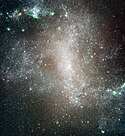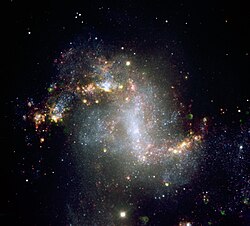NGC 1313
| Galaxie NGC 1313 | |
|---|---|
 | |
| Aufnahme mithilfe des Víctor M. Blanco Telescope | |
| AladinLite | |
| Sternbild | Netz |
| Position Äquinoktium: J2000.0, Epoche: J2000.0 | |
| Rektaszension | 03h 18m 16,0s[1] |
| Deklination | −66° 29′ 54″[1] |
| Erscheinungsbild | |
| Morphologischer Typ | SB(s)d / HII[1] |
| Helligkeit (visuell) | 9,1 mag[2] |
| Helligkeit (B-Band) | 9,8 mag[2] |
| Winkelausdehnung | 9,2′ × 7,2′[2] |
| Positionswinkel | 38°[2] |
| Flächenhelligkeit | 13,5 mag/arcmin²[2] |
| Physikalische Daten | |
| Rotverschiebung | 0.001568 ± 0.000007[1] |
| Radialgeschwindigkeit | (470 ± 2) km/s[1] |
| Hubbledistanz H0 = 73 km/(s • Mpc) | (14 ± 1) · 106 Lj (4,19 ± 0,31) Mpc [1] |
| Durchmesser | 50.000 Lj[3] |
| Geschichte | |
| Entdeckung | James Dunlop |
| Entdeckungsdatum | 27. September 1826 |
| Katalogbezeichnungen | |
| NGC 1313 • PGC 12286 • ESO 82-G011 • IRAS 03176-6640 • 2MASX J03181604-6629537 • SGC 031739-6640.7 • AM 0317-664 • VV 436 • GC 695 • h 2528 • Dun 206 • HIPASS J0317-66 | |
NGC 1313 ist eine Balkenspiralgalaxie vom Hubble-Typ SB(s)d im Sternbild Netz am Südsternhimmel. Sie ist schätzungsweise 14 Millionen Lichtjahre von der Milchstraße entfernt, hat einen Durchmesser von etwa 50.000 Lj und wird als sogenannte Starburstgalaxie klassifiziert. Auffallend ist die ungleichmäßige Form der Spiralarme, deren Rotationsachse zudem nicht genau im Zentrum liegt.[4] 16 Bogenminuten südöstlich von NGC 1313 befindet sich eine weitere Balkenspiralgalaxie (vom Hubble-Typ SBb), welche als NGC 1313A (= PGC 12457, ESO 83-1) bezeichnet wird. In NGC 1313 wurden bisher zwei Supernovae gesichtet, nämlich SN 1962M (Typ II-P) und SN 1987K (Typ IIb).
NGC 1313 wurde am 27. September 1826 vom schottischen Astronomen James Dunlop entdeckt.[5]
- Aufnahme des Zentralbereichs der Galaxie NGC 1313 mit dem Very Large Telescope unter Verwendung von Linienfiltern
- Zentrum hochaufgelöst aufgenommen vom Hubble-Weltraumteleskop
Literatur
- König, Michael & Binnewies, Stefan (2019): Bildatlas der Galaxien: Die Astrophysik hinter den Astrofotografien, Stuttgart: Kosmos, S. 219
Weblinks
- ESO: Die durcheinandergewirbelte Galaxie NGC 1313
- astronews.com: Bild des Tages 10. Januar 2013
- ESO: The Topsy-Turvy Galaxy 23. November 2006 (engl.)
- Antilhue – Chile
- GoBlack
- Anglo-Australian Observatory (Memento vom 22. Februar 2014 im Internet Archive)
- CDS Portal
- astronews.com: Kurzlebige stellare Kinderstuben 18. Januar 2007
- Unusual Starburst Galaxy NGC 1313 – Astronomy Picture of the Day vom 28. November 2006 (englisch).
- Tumult in NGC 1313. Auf: wissenschaft.de vom 28. November 2006
Einzelnachweise
Auf dieser Seite verwendete Medien
Autor/Urheber:
Credit:
Credit:T.A. Rector/University of Alaska Anchorage, T. Abbott and NOIRLab/NSF/AURA, Lizenz: CC BY 4.0Barred Spiral Galaxy, NGC 1313
This image of nearby spiral galaxy NGC1313 was taken with the National Science Foundation’s Blanco 4-meter telescope at Cerro Tololo Inter-American Observatory in Chile. NGC1313 is a late-type barred spiral galaxy. In visible light, NGC1313 appears dominated by scattered regions of star formation, giving it a rather ragged appearance. The clouds of bluish stars look to have burst into existence at random, without the normal trigger of gravitational interaction or even distinct spiral processes to prompt them. Deep images show that the outer parts of galaxy are also very disturbed. When observed at radio wavelengths, the galaxy is found to be rich in hydrogen, the raw material of stars. The gas circulates around the center of the galaxy in a well-ordered way, as opposed to its irregular appearance in visible light. NGC1313 is located about 15 million light-years from Earth in the constellation Reticulum.
This is a NASA Hubble Space Telescope image of the central region of the barred spiral galaxy NGC 1313. Hubble was used to resolve stars within the galaxy to do a census of various classes of stars distributed across the galaxy. The observations show that hot blue stars (of class B) are widely scattered across the galaxy. This is evidence of infant mortality in which the young, so-called open clusters where stars are born, quickly became gravitationally "unglued" and scattered their resident stars into the galaxy.
Autor/Urheber: ESO, Henri Boffin, Lizenz: CC BY 4.0
The central parts of the starburst galaxy NGC 1313. The very active state of this galaxy is very evident from the image, showing many star formation regions. A great number of supershell nebulae, that is, cocoon of gas inflated and etched by successive bursts of star formation, are visible. The green nebulosities are region emitting in the ionised oxygen lines and may harbour clusters with very hot stars. This colour-composite is based on images obtained with the FORS1 instrument on one of the 8.2-m Unit Telescope of ESO's Very Large Telescope, located at Cerro Paranal. The data were obtained in the night of 16 December 2003, through different broad- (R, B, and z) and narrow-band filters (H-alpha, OI, and OIII). The data were extracted from the ESO Science Archive and fully processed by Henri Boffin (ESO).
ID: phot-43a-06
Press Release: ESO 43/06
Long Caption
Object: NGC 1313
Telescope: UT2/Kueyen
Instrument: FORS1
Credit: ESO



